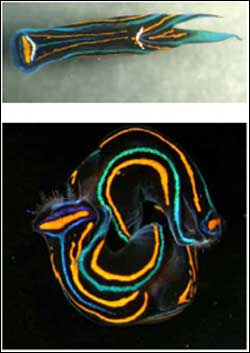Sperm trading can resolve hermaphrodite mating conflicts

Credit: Anthes et al./Current Biology
By directly manipulating mating performance in a tropical sea slug, Chelidonura hirundinina, researchers of the University of Tübingen have now shed light on the bizarre reproductive conflicts encountered by hermaphroditic animals. In some hermaphroditic species, such as C. hirundinina, mating partners may insist on copulating as a “male,” “female,” or both, resulting in unique biological conflicts over gender.
Sexual interactions in so-called cross-fertilizing simultaneous hermaphrodites, such as earthworms, snails, leeches, and some fishes, have long challenged researchers’ understanding of how established theories regarding sexual selection apply in cases of hermaphroditic species. For example, combining male and female gender in one and the same individual, hermaphrodites have been predicted to frequently be at conflict (theoretically speaking) about which sexual roles to play, because matings are often more costly, in terms of evolutionary fitness, to one gender than to the other. In such cases, hermaphrodites are predicted to share a preference to copulate in the more beneficial gender role. This would appear to make the interests of any two potential mates incompatible. For 20 years, evolutionary biologists have speculated that hermaphrodites may solve such mating conflicts by “trading sperm,” that is, giving sperm only when the mating partner follows suit. However, this prediction had never been proven experimentally.
In the new work, researchers Nils Anthes, Annika Putz, and Nico Michiels generated individual sea slug hermaphrodites only capable of performing a “dry” copulation–that is, without sperm transfer. Sea slugs that mated with such a “cheating” partner interrupted sexual intercourse significantly sooner than did control pairs. This supports the concept of sperm trading, where mates negotiate mating roles in order to balance sexual interactions.
Media Contact
More Information:
http://www.current-biology.comAll latest news from the category: Life Sciences and Chemistry
Articles and reports from the Life Sciences and chemistry area deal with applied and basic research into modern biology, chemistry and human medicine.
Valuable information can be found on a range of life sciences fields including bacteriology, biochemistry, bionics, bioinformatics, biophysics, biotechnology, genetics, geobotany, human biology, marine biology, microbiology, molecular biology, cellular biology, zoology, bioinorganic chemistry, microchemistry and environmental chemistry.
Newest articles

Economies take off with new airports
A global study by an SUTD researcher in collaboration with scientists from Japan explores the economic benefits of airport investment in emerging economies using nighttime satellite imagery. Be it for…

CAR T–cell immunotherapy targets
Pan-cancer analysis uncovers a new class of promising CAR T–cell immunotherapy targets. Scientists at St. Jude Children’s Research Hospital found 156 potential CAR targets across the brain and solid tumors,…

Stony coral tissue loss disease
… is shifting the ecological balance of Caribbean reefs. The outbreak of a deadly disease called stony coral tissue loss disease is destroying susceptible species of coral in the Caribbean…





















